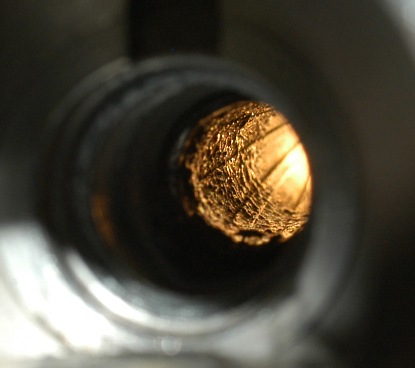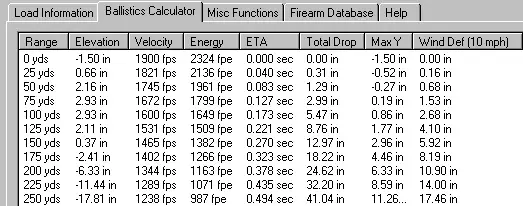


Basic Inline Ballistics: Triple Se7en and Blackhorn 209
Things are rarely what they seem to be when it comes to inline muzzleloading ballistics. For starters, let's look at the standard Knight Rifles "three Triple Se7en pellet load" for a 300 grain Barnes MZ-Expander, exactly as published by Knight.


Despite the "warning" from Hodgdon that two pellets are the maximum load, the three pellet magnumitis load has been hyped and published by not only Knight, but Thompson and others as well. This includes Hodgdon as well that publishes three pellet load data for "IMR White Hots" although they "warn" you that you can't use it. Regardless of the pseudo warnings, three pellet loads have been hyped for years by now. Regardless how you get there, 1900 fps or so remains 1900 fps.
For comparison, let's look at Blackhorn 209 load velocities.

Yes, you're reading it correctly. Not only does the 120 grain by volume Blackhorn 209 charge (84 grains actual weight) yield far better velocities than the "150 grain pellet load," a 100 grain by volume of Blackhorn 209 propellant is essentially the equivalent of "Magnum Three Pellet" loads.
A bottle of Blackhorn 209 nets you about 62 shots at 1900 fps velocities, as shown above, for $23 currently from Midway USA as this article is written. Midway uses $28.99 as their regular price. A pack of Triple Se7en pellets goes for $27.49 from Midway USA, giving you 33 shots of the three pellet "magnum" variety. Sales and promos vary throughout the year, but in rough terms Blackhorn 209 is about half the cost per shot of Triple Se7en pellets comparing velocity against velocity.
If you want to cut your propellant costs in half with similar velocities, use Blackhorn 209. That's not the main reason to use it, however. After packs of pellets are opened, they quickly absorb moisture and lose their potency. It is why last year's pellets might fizzle more than sizzle for you, not giving you the same point of impact you expected.
Three pellet loads are easily crushed and cracked when loading, yielding erratic pressures and velocities. With Triple Se7en, we also have the unhappy potential of seized breechplugs and hard crud rings that make repeat loadings and repeatable accuracy problematic without licking a cotton patch and going up and down the bore. Corrosion remains a concern.

Above is the bore crud left behind by one Triple Se7en shot. While not as caustic and aggressively corrosive as Pyrodex, Triple Se7en can still destroy a barrel. While no propellant is absolutely, completely non-corrosive, Blackhorn 209 comes close. "Essentially non-corrosive" is the best way to describe it.
No blackpowder replacement propellant is labeled with ingredients, primarily because no one cares. 1900 fps is 1900 fps, whether you get it from sulfurless perchlorate-enhanced rocket fuel like Triple Se7en, or you get it from a patented, two-part extruded propellant like Blackhorn 209. Ironically, sulfurless Triple Se7en is more corrosive than Blackhorn 209, which (like organic black powder) contains sulfur. Go figure.
A couple of years ago I asked the question, "Are Pellets for Dummies?" See: http://randywakeman.com/ArePelletsForDummies.htm . If you refer to that article and consider all the negatives associated with pellets, you'll come to the same conclusion: pellets are far from a good path and you cannot properly work up a load with the "take three pellets and call me in the morning" type mentality.
When it comes to exterior ballistics, there are only two basic considerations: muzzle velocity and ballistic coefficient. Saboted bullets are superior as a matter of course to "bore size" projectiles for the simple reason that .50 caliber projectile flight characteristics cannot compete with .45 caliber flight characteristics for bullets of the same weight. Charts are invariably wrong. They have to be, as ballistic coefficients may vary by 30% or more based on ambient conditions. There is no substitute for doing your own homework with your rifle at the ranges you intend to shoot at, before the hunt.
Deer don't care how fast you miss them and there is not yet remotely any substitute for good shot placement. That's why the "best load" is the load that shoots the most accurately out of your gun. 250 - 300 grain forty-five caliber exterior ballistics fall into a fairly narrow range, so becoming familiar with the trajectory of your rifle, under your ambient conditions, with your scope height, etc., trumps many other considerations.
Naturally, I well understand that many folks would like a starting point. 100 grains by volume Blackhorn 209 (70 grains by actual weight) yields the following approximate ballistics, varying by rifle, ambient conditions, and so forth . . . with a Barnes Spitfire T-EZ FB 290 grain saboted bullet:

Gravity is of course wonderfully repeatable, but sadly wind is not. Just a ten mph direct crosswind can move our bullet over 17 inches at 250 yards, which is why closer is better. Things can get ugly in a hurry past 200 yards or so, contingent on your specific hunting conditions. It just makes practice and familiarity with your individual rifle all the more important.
Pellets are for losers and nothing beats good shot placement may be an oversimplification, but it remains pretty close to the truth. The well-practiced shooter will always be miles ahead of and more successful than those that just like to guess. If you settle for the most accurate load from your individual rifle and become familiar with its trajectory from your individual rifle, you'll be far better equipped to fill your meat locker than most.
Copyright 2010 by Randy Wakeman. All Rights Reserved.



